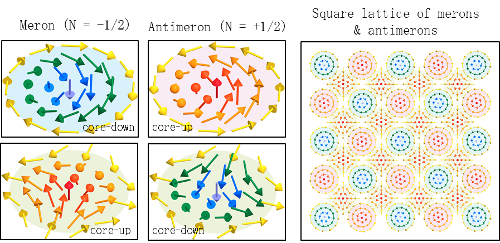Dec. 6, 2018 Press Release Physics / Astronomy
First observation of a square lattice of merons and antimerons
Scientists have, for the first time, observed a square lattice of merons and antimerons—tiny magnetic vortices and antivortices that form in a thin plate of the helical magnet Co8Zn9Mn3. By finely varying a magnetic field applied perpendicularly to the thin plate, the researchers were able to induce a transformation between the square lattice of merons-antimerons and a hexagonal lattice of skyrmions, another form of vortex that is topologically different from merons and antimerons.
The ability to manipulate nanometer-scale spin textures such as merons and skyrmions is a key to the development of spintronics—next-generation electronic devices that are very low in power consumption. The secret to their low power consumption is that they make use of the topological spin texture—a property that emerges when electrons interact in a solid. To perform the experiments, published in Nature, the group used a thin magnetic sample made of an alloy of cobalt, zinc, and manganese, Co8Zn9Mn3, which is known as a chiral magnet. They used an extremely weak magnetic field to coax the tiny vortices to form in the thin sample, and observed them with Lorentz electron microscopy.
“It is well known in nature,” says Xiuzhen Yu of the RIKEN Center for Emergent Matter Science (CEMS), the first author of the paper, “that external stimuli can trigger a structural transition of crystals between tetragonal and hexagonal lattices, and it had been predicted that this would be seen in topological spin-textures as well. It was very satisfying to be able to show that this idea was indeed true, when we witnessed the merons transformed into skyrmions as we carefully increased the magnetic field.”
The experiments did, however, give the researchers some surprises. Using the thin plate sample, they experimented with lowering the temperature to see how it would affect the textures. According to Yu, “We found that the skyrmions were very robust, lasting even as we lowered the temperature of the thin plate, but the merons and antimerons were much more sensitive, and relaxed into spin helices as the temperature fell. This could have implications for the manipulation of these textures in future spintronic devices. In the future, we plan to do studies using not only magnetic anisotropy, but also local strain to control spin textures.”
The work was done by researchers from RIKEN CEMS along with the University of Tokyo.
Reference
- Xiuzhen Yu, Wataru Koshibae, Yusuke Tokunaga, Kiyou Shibata, Yasujiro Taguchi, Naoto Nagaosa and Yoshinori Tokura, "Transformation of topological spin textures between skyrmion and meron in a chiral magnet", Nature, 10.1038/s41586-018-0745-3
Contact
Team Leader
Xiuzhen Yu
Electronic States Microscopy Research Team
RIKEN Center for Emergent Matter Science
Group Director
Yasujiro Taguchi
Strong Correlation Materials Research Group
RIKEN Center for Emergent Matter Science
Group Director
Naoto Nagaosa
Strong Correlation Theory Research Group
RIKEN Center for Emergent Matter Science
Group Director
Yoshinori Tokura
Strong Correlation Physics Research Group
RIKEN Center for Emergent Matter Science
Jens Wilkinson
RIKEN International Affairs Division
Tel: +81-(0)48-462-1225 / Fax: +81-(0)48-463-3687
Email: pr@riken.jp

Square lattice of merons and antimerons
